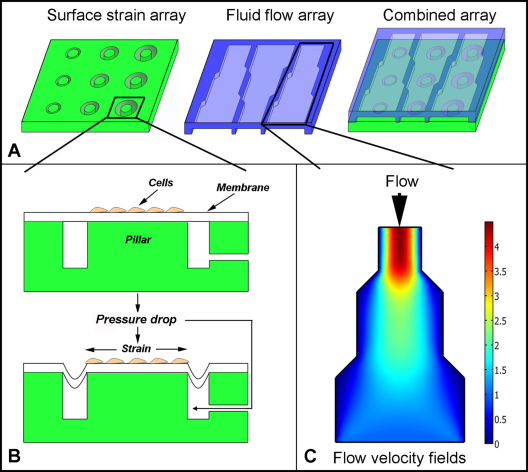A lab-on-a-chip device to screen for the effect of mechanical signals on cells
Staff members
PhD students
Ravi Sinha
Goal
The goal of this project is to refine mechanobiological modelling and advance prevascularized bone tissue engineering by characterizing the effect of mechanical signals on bone precursor cells, endothelial cells, and co-cultures of these cells, using a novel semi-high throughput screening system.
Background
Mechanical signals have a strong effect on tissue development and organization. Optimal integration of an engineered tissue is only possible if this tissue is tailored to the mechanical environment after implantation.
In order to prepare engineered tissues for a mechanical environment, one needs to understand the effects of mechanical signals on cells and tissues. We and others are working on mathematical models to predict tissue differentiation and –organization based on the mechanical environment. These models are based on the behavior of bone precursor cells due to two mechanical signals; fluid velocity and strain. However, current models have several drawbacks:
- The values at which cell differentiation shifts from one cell type to the other are arbitrary due to lack of experimental data.
- The effect of strain and shear stresses on cell proliferation, migration, and survival is often ignored due to lack of experimental data.
- The inclusion of blood vessels is possible in models, but there are no data available about the effect of mechanical signals on co-cultures of the different cell types that are present in these complex tissues.
This illustrates the clear need for a screening system that can determine the effect of strains and shear stresses on (combinations of) different cell populations. Such a system should have the following characteristics:
- It should be able to screen for the combined effect of surface strains and shear stresses.
- It should be able to screen for a high number of combinations in a single experiment (to illustrate this; the combined effect of 5 different surface strains and 5 different shear stresses with 4 different cell populations results in 5x5x4=100 combinations).
Future plans
Within this project, a novel lab-on-a-chip based semi-high throughput system to screen for the combined effect of surface strains and shear stresses on multiple cell populations will be developed. This system will then be used to characterize the effect of these signals on the cell populations that are needed for prevascularized bone tissue engineering.
As such, this project will result in a vast refinement of mechanobiological modeling. This allows for a better preconditioning of engineered tissues to the mechanical environment after implantation. It will also advance the complementation of bone tissue engineering with vascular tissue engineering, which is a promising strategy to increase the size of engineered tissues that survive after implantation to a clinically relevant scale.
Schematic overview of the system that will be developed

Getting involved
Are you a master or bachelor student and would you like to participate in this research, please send an email to Jeroen Rouwkema (j.rouwkema@utwente.nl). We are always on the look-out for good students.
